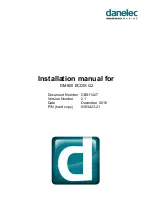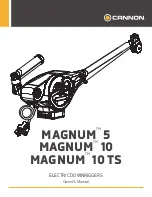
8
Instructions for use
|
Dräger SPC 4700
|
Safety-related information
Dräger SPC 4700
1 Safety-related
information
1.1 General
safety
instructions
– Before using this product, carefully read these instructions for use and those
of the associated products.
– Strictly follow the instructions for use. The user must fully understand and
strictly observe the instructions. Use the product only for the purposes
specified in the intended use section of this document.
– Do not dispose of the instructions for use. Ensure that they are retained and
appropriately used by the product user.
– Only trained and competent users are permitted to use and check this
product.
– Comply with all local and national rules and regulations associated with this
product.
– Do not use a faulty or incomplete product. Do not modify the product.
– Notify Dräger in the event of any component fault or failure.
These instructions for use can be downloaded in other languages in
electronic format from the appropriate product page (www.draeger.com/ifu) or
obtained free of charge as a printed copy from Dräger or the specialist shop.
2
Conventions in this document
2.1
Meaning of the warning notes
The following warning notes are used in this document to notify users of
possible dangers. The meanings of the warning notes are defined as follows:
3 Principles
of operation
3.1 Product
overview
SPC 4700 chemical protective suit (see figure A on page 2)
CVA 0700 ventilation vest (see figure D on page 2)
3.2 Feature
description
The chemical protective suit is certified as Category III personal protective
clothing.
The Dräger CVA 0700 ventilation vest is used for the breathing air supply and
constant ventilation of the chemical protective suit. This vest is connected to an
external air supply. The user can breathe directly from the inside of the suit.
Excess air escapes via the suit valves. Heat and moisture are released from the
chemical protective suit this way and the user feels a cooling effect.
Gloves and socks are permanently attached to the chemical protective suit. If
the suit has laminate gloves, arm cuffs cover any gap between the suit and
gloves. Additional overgloves can be worn to improve the resistance to
chemical and mechanical erosion. If the chemical protective suit has a leg cuff
and socks made from suit material, the safety shoes or safety boots are worn
over the suit socks and the leg cuff is pulled down over the boots. If the
chemical protective suit has boot socks with non-slip soles, the safety shoes or
safety boots are worn inside the suit.
The zip is on the back and is protected by a double cover flap.
To get out of the suit quickly in case of emergency, the suit is equipped with an
emergency flap underneath the visor.
3.3 Intended
use
The chemical protective suit protects the wearer against organic and inorganic
fluids, radioactive contamination and against viruses and bacteria. It also
protects against incorporation of radioactive particles.
The chemical protective suit can also be used if sensitive products must be
protected against contamination caused by humans.
The chemical protective suit is intended for limited use. It may only be used a
second time if it is not damaged or contaminated. The use must also be
acceptable from a hygienic standpoint. The chemical protective suit cannot be
cleaned and sterilised again.
3.4
Limitations on intended use
The chemical protective suit should not be exposed to substances in higher
concentrations than those tested. Substances with higher concentrations
require other protective clothing. This chemical protective suit may not provide
protection in certain highly-toxic atmospheres.
Exposure to hazardous biological substances that do not comply with the
tightness of the suit can cause biocontamination of the wearer. For information
on mechanical and chemical resistance, as well as on temperature resistance
(see "Technical data", page 10).
Avoid heat and open flames. The chemical protective suit is not suitable for
firefighting applications. For permissible application temperatures (see
"Technical data", page 10). The chemical protective suit does not provide any
protection against radiation of radioactive particles or radiation damage.
The person wearing the electrostatic dissipative protective clothing shall be
properly earthed. The resistance between the person skin and earth shall be
less than 10
8
Ω
e.g. by wearing adequate footwear on dissipative or conductive
floors.
Electrostatic dissipative protective clothing shall not be open or removed whilst
in presence of flammable or explosive atmospheres or while handling
flammable or explosive substances.
Electrostatic dissipative protective clothing is intended to be worn in Zones 1, 2,
20, 21 and 22 (see EN 60079-10-1 [7] and EN 60079-10-2 [8]) in which the
minimum ignition energy of any explosive atmosphere is not less than 0,016
mJ.
Electrostatic dissipative protective clothing shall not be used in oxygen enriched
atmospheres, or in Zone 0 (see EN 60079-10-1 [7]) without prior approval of the
responsible safety engineer.
The electrostatic dissipative performance of the electrostatic dissipative
protective clothing can be affected by wear and tear, laundering and possible
contamination.
Electrostatic dissipative protective clothing shall be worn in such a way that it
permanently covers all non-complying materials during normal use (including
bending movements).
Alert icon
Signal word
Consequences in case of nonob-
servance
WARNING
Indicates a potentially hazardous situa-
tion. If not avoided, it could result in
death or serious injury.
CAUTION
Indicates a potentially hazardous situa-
tion. If not avoided, it could result in
physical injury. It may also be used to
alert against unsafe practices.
NOTICE
Indicates a potentially hazardous situa-
tion. If not avoided, it could result in
damage to the product or environment.
1
Input tunnel for external air supply with internal rubber cuff (see figure E
on page 2)
2
Zip with cover flap (see figure G on page 2)
3
Suit valves
4
Air outlet for breathing air supply
5
Chest strap
6
Air line breathing apparatus
7
Connector of the air line breathing apparatus for external air supply
(medium-pressure hose)
8
Quick-release buckle
9
Waist belt
10
Side harness
11
Quick-release buckle
12
Zip to regulate cooling









































